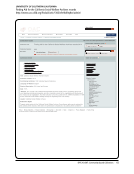124 · Representative Documents: Finding Aids and Guides
UNIVERSITY OF ILLINOIS AT CHICAGO
Bethlehem Howell Neighborhood Center Collection
http://www.uic.edu/depts/lib/specialcoll/services/rjd/findingaids/BHNCf.html
Bethlehem Howell Neighborhood Center collection MSBHNC70 An inventory of the collection at the University of Illinois at Chicago
http://www.uic.edu/depts/lib/specialcoll/services/rjd/findingaids/BHNCf.html[6/23/15, 2:21:06 PM]
mission's first initiative in the "Little Pilsen" neighborhood
was a kindergarten in a small building on the corner of
Nineteenth Place and May Street. "To stand on the corner
of Blue Island Avenue and 18th Street [in those days],"
Gertrude Ray later wrote, "was to stand in the heart of a
Czech city with a population second only to Prague." The
house expanded rapidly and by 1914, the board of
management had created, among others, Boys and Girls
Clubs, a Sunday school, a library, and an English Night
School. C.D.B. Howell, for whom the settlement house
was later renamed in 1919, taught Sunday school and
brought in other teachers from the neighborhood in these
formative years. Additionally, Howell led a fund-raising
drive in 1913 that raised money for construction of a
larger settlement building at 1831 South Center Street
(now Racine). Gertrude Ray, one of the most significant
figures of the Howell Neighborhood House, served as both
worker and head resident from 1910 to 1945. After
retiring briefly to Florida, she returned to Howell House in
1952 to serve on its board of directors. Ray remained one
of the most revered and admired members in Howell
House history. Just like Bethlehem House, the Howell
Neighborhood Center succumbed to the changing
demographics and needs of the Pilsen neighborhood.
Howell House later became the main building housing the
Neighborhood Service Organization.
Return to Table of Contents »
SCOPE AND CONTENTS
This collection reflects the activities performed by both the
Bethlehem and Howell Neighborhood Houses and their
relationships with outside government bodies, community
organizations, settlement houses, religious institutions and
service agencies. The bulk of the work consists of
correspondences, reports, and community activity from
1935 to 1955. The BHNC collection provides hundreds of
documents depicting second-generation immigrant social
and community life in the Chicago's Pilsen Neighborhood.
Though Bethlehem and Howell House documents remain
separate, both files contain Board reports, staff
correspondences, newsletters ,class schedules, church
rosters, donation records, settlement publicity, newspaper
clippings, individual club records, letters from World War
II soldiers, and numerous photographs.
The Bethlehem House is divided into three series reflecting
the administrative structure, house activities, and
photographs. The first series, administrative records, is
divided into newsletters, board minutes, board reports,
and finance. The second series, programs, is divided into
camp, church, classes, clubs, and community subseries.
Both administrative records and programs illustrate how
Bethlehem House extended its services and concern well
UNIVERSITY OF ILLINOIS AT CHICAGO
Bethlehem Howell Neighborhood Center Collection
http://www.uic.edu/depts/lib/specialcoll/services/rjd/findingaids/BHNCf.html
Bethlehem Howell Neighborhood Center collection MSBHNC70 An inventory of the collection at the University of Illinois at Chicago
http://www.uic.edu/depts/lib/specialcoll/services/rjd/findingaids/BHNCf.html[6/23/15, 2:21:06 PM]
mission's first initiative in the "Little Pilsen" neighborhood
was a kindergarten in a small building on the corner of
Nineteenth Place and May Street. "To stand on the corner
of Blue Island Avenue and 18th Street [in those days],"
Gertrude Ray later wrote, "was to stand in the heart of a
Czech city with a population second only to Prague." The
house expanded rapidly and by 1914, the board of
management had created, among others, Boys and Girls
Clubs, a Sunday school, a library, and an English Night
School. C.D.B. Howell, for whom the settlement house
was later renamed in 1919, taught Sunday school and
brought in other teachers from the neighborhood in these
formative years. Additionally, Howell led a fund-raising
drive in 1913 that raised money for construction of a
larger settlement building at 1831 South Center Street
(now Racine). Gertrude Ray, one of the most significant
figures of the Howell Neighborhood House, served as both
worker and head resident from 1910 to 1945. After
retiring briefly to Florida, she returned to Howell House in
1952 to serve on its board of directors. Ray remained one
of the most revered and admired members in Howell
House history. Just like Bethlehem House, the Howell
Neighborhood Center succumbed to the changing
demographics and needs of the Pilsen neighborhood.
Howell House later became the main building housing the
Neighborhood Service Organization.
Return to Table of Contents »
SCOPE AND CONTENTS
This collection reflects the activities performed by both the
Bethlehem and Howell Neighborhood Houses and their
relationships with outside government bodies, community
organizations, settlement houses, religious institutions and
service agencies. The bulk of the work consists of
correspondences, reports, and community activity from
1935 to 1955. The BHNC collection provides hundreds of
documents depicting second-generation immigrant social
and community life in the Chicago's Pilsen Neighborhood.
Though Bethlehem and Howell House documents remain
separate, both files contain Board reports, staff
correspondences, newsletters ,class schedules, church
rosters, donation records, settlement publicity, newspaper
clippings, individual club records, letters from World War
II soldiers, and numerous photographs.
The Bethlehem House is divided into three series reflecting
the administrative structure, house activities, and
photographs. The first series, administrative records, is
divided into newsletters, board minutes, board reports,
and finance. The second series, programs, is divided into
camp, church, classes, clubs, and community subseries.
Both administrative records and programs illustrate how
Bethlehem House extended its services and concern well
























































































































































































